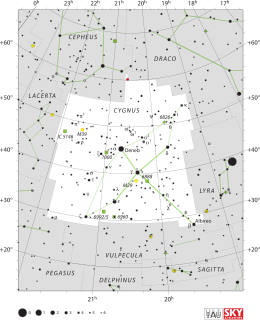NML Cygni
NML Cygni o NML Cyg è una stella ipergigante rossa[4], situata a circa 5500 anni luce[5] dalla Terra nella costellazione del Cigno. Attualmente, è una delle stelle più grandi tra quelle conosciute, con un raggio pari a 1183 volte quello del Sole[2]. La sua massa si aggira intorno alle 50 M⊙[3]. È stata scoperta da Neugebauer, Martz e Leighton nel 1965[6], e il nome NML Cygni deriva dai nomi di questi tre scopritori[7].
| NML Cygni | |
|---|---|
| Classificazione | Ipergigante rossa |
| Classe spettrale | M6III[1] |
| Tipo di variabile | Semiregolare |
| Distanza dal Sole | 5500 anni luce |
| Costellazione | Cigno |
| Coordinate | |
| (all'epoca J2000) | |
| Ascensione retta | 20h 46m 25,5s[1] |
| Declinazione | 40° 06′ 59,4″[1] |
| Dati fisici | |
| Raggio medio | 1640-2775-1183[2] R⊙ |
| Massa | |
| Luminosità | |
| Dati osservativi | |
| Magnitudine app. | 16,60[1] |
| Nomenclature alternative | |
V1489 Cyg, RAFGL 2650, IRC +40448
| |
La stella è circondata da una nebulosa a forma di fagiolo. Si tratta di una variabile semiregolare con un periodo di variabilità di circa 940 giorni[8].
NML Cygni fa parte dell'associazione OB OB2 Cygnus e la sua parallasse misura circa 0,62 mas[4]; con una magnitudine bolometrica di -9,0 è una delle stelle più luminose conosciute[8].
La stella ha un tasso di perdita di massa dovuta al vento stellare stimato in 2 × 10−4 M⊙ all'anno (il che equivale alla perdita di una massa solare ogni 5000 anni)[3]; si tratta di uno dei tassi più alti conosciuti.
Note
modifica- ^ a b c d V* V1489 Cyg, su SIMBAD, Centre de données astronomiques de Strasbourg. URL consultato il 29 settembre 2012.
- ^ a b E. De Beck, L. Decin, A. De Koter, K. Justtanont, T. Verhoelst, F. Kemper e K. M. Menten, Probing the mass-loss history of AGB and red supergiant stars from CO rotational line profiles. II. CO line survey of evolved stars: Derivation of mass-loss rate formulae, in Astronomy and Astrophysics, vol. 523, 2010, pp. A18, Bibcode:2010A&A...523A..18D, DOI:10.1051/0004-6361/200913771, arXiv:1008.1083.
- ^ a b c Robin Pulliam, Anthony Remijan, Joanna Corby, Mapping the Molecular Envelope of the Hypergiant NML Cyg (PDF), su safe.nrao.edu, National Radio Astronomy Observatory. URL consultato il 29 settembre 2012 (archiviato dall'url originale il 6 ottobre 2014).
- ^ a b c B. Zhang et al., The distance and size of the red hypergiant NML Cygni from VLBA and VLA astrometry, in Astronomy And Astrophisics, vol. 544, 2012, DOI:10.1051/0004-6361/201219587. URL consultato il 29 settembre 2012.
- ^ Michael Thomas Schuster, Investigating the Circumstellar Environments of the Cool Hypergiants[collegamento interrotto], ProQuest, 2007, p. 57, ISBN 978-0-549-32782-0. URL consultato il 27 agosto 2012.
- ^ Kevin Marvel, The Circumstellar Environment of Evolved Stars As Revealed by Studies of Circumstellar Water Masers, Universal-Publishers, 19 dicembre 1996, pp. 182-212, ISBN 978-1-58112-061-5. URL consultato il 23 agosto 2012.
- ^ J. B. Hearnshaw, The Measurement of Starlight: Two Centuries of Astronomical Photometry, Cambridge University Press, 2 maggio 1996, p. 278, ISBN 978-0-521-40393-1. URL consultato il 23 agosto 2012.
- ^ a b Schuster, M. T.; Marengo, M.; Hora, J. L.; Fazio, G. G.; Humphreys, R. M.; Gehrz, R. D.; Hinz, P. M.; Kenworthy, M. A. et al., Imaging the Cool Hypergiant Nml Cygni's Dusty Circumstellar Envelope with Adaptive Optics, in The Astrophysical Journal, vol. 693, 2009, p. 1423, DOI:10.1088/0004-637X/699/2/1423.
Voci correlate
modificaAltri progetti
modifica- Wikimedia Commons contiene immagini o altri file su NML Cygni
